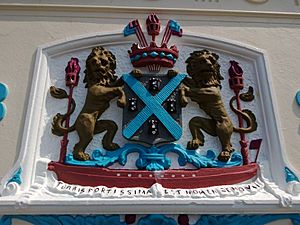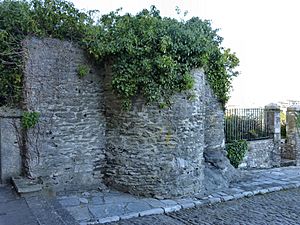Plymouth Castle facts for kids
Plymouth Castle was a strong castle built a long time ago, in the early 1400s. It was made to protect the town and harbour of Plymouth in Devon, England. By the late 1500s, the castle was no longer used for defence. It slowly fell apart and was mostly taken down by the 1800s. Today, only a small piece of one of its outer gatehouses is left.
History of Plymouth Castle

When the Normans took over England in 1066, Plymouth was a small place called Sutton. It was too tiny to need its own castle. Instead, a simpler motte and bailey castle was built nearby in Plympton.
As Plymouth grew and its natural harbour, Sutton Pool, became more important, people wanted to protect it. In 1377, the town received a special grant called a murage. This money was meant to help build town defences.
We don't know the exact year Plymouth Castle was built. But after French raiders attacked Plymouth in 1403, King Henry IV ordered the town to build walls and towers. The king didn't send money for this project. So, a bishop named Edmund Lacey offered special religious rewards, called indulgences, to anyone who helped pay for the castle.
Instead of long town walls, the defence was a quadrangular castle. This means it was a square-shaped castle with four strong towers at each corner. This castle was not owned by a powerful noble or a royal officer. Instead, the town's mayor was in charge. The town's aldermen (local leaders) were responsible for defending it. Each of the four areas, or wards, of the town looked after one of the four towers. You can still see these four towers on the city's coat of arms today!
In 1542, a historian named John Leland visited Plymouth. He wrote that the castle was on a rocky hill near the harbour's mouth. He described it as a strong square castle with a big round tower at each corner. He thought it looked quite new.
During the Prayer Book Rebellion in 1549, the castle was a safe place for the town's leaders. Later, in 1588, the castle was made ready again when the Spanish Armada threatened England. However, Francis Drake got money from the queen to build a new, modern fort. This new fort was built on Plymouth Hoe and became the main defence for the harbour. It took over the castle's role.
During the English Civil War in the 1640s, Plymouth supported Parliament. Royalist forces attacked the town in 1643. The castle was prepared for battle, but it didn't see any fighting. After that, the castle was used as a prison. Then it became a workhouse, a place where poor people could live and work. Finally, its stones were used to build other parts of the growing town.
What's Left Today
Only a small part of Plymouth Castle still stands. You can find it in the Barbican area of Plymouth, on Lambhay Street. It's at the top of some stairs that go down to the Mayflower Steps by the water.
This remaining piece is thought to be part of an outer gatehouse that was called the "South Port". It's a short, thick wall made of rubble, about 3 metres (10 feet) high. It has a rounded part in the middle, which is what's left of a small tower from the gatehouse. This small ruin is protected as a Grade II listed building. This means it's an important historical building. It's also a Scheduled Ancient Monument, which gives it even more protection.


